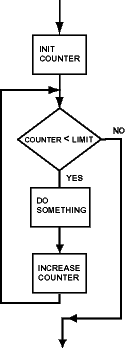Counting Loop

A common program loop is controlled by an integer that counts up from a initial value to an upper limit. Such a loop is called a counting loop. The integer is called a loop control variable. Loops are implemented with the conditional branch, jump, and conditional set instructions.
A loop has three parts that must be correct:
- The counter must be initialized.
- The test must end the loop on the correct count.
- The counter must be increased.
It is easy to get these wrong in a high-level programming language. It is remarkably easy to get them wrong in assembly language.
Usually you want a top-driven loop such as the one at right, where the test is performed at the top before control enters the loop body. Be clear about the loop you want before you program it, because assembly language allows any sort of weird loop.